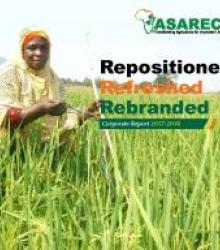| elibrary image | Title | Author | elibrary Type | Keywords | Asbract |
|---|---|---|---|---|---|
| Maize Lethal Necrosis: History and Control in the Western Hemisphere | Peg Redinbaugh | Presentations | |||
| Plant virome ecology in African farming systems: assessing food security “Alternate hosts for the viruses in weeds and non-maize crops” | Francesca Stomeo / Mark Wamalwa | Presentations | Plant virome ecology in African farming systems: assessing food security “Alternate hosts for the viruses in weeds and non-maize crops” |
||
| Tackling the MLN Challenge through R4D – Initiatives by CIMMYT and Partners | BM Prasanna | Presentations | Tackling the MLN Challenge through R4D – Initiatives by CIMMYT and Partners |
||
| Status and progress of research on maize lethal necrosis disease (MLND) in Kenya | Dr Anne Wangai | Presentations | Status and progress of research on maize lethal necrosis disease (MLND) in Kenya |
||
| Understanding the Recent Food Price Trends in Uganda | Swaibu Mbowa, Joseph Mawejje and Ibrahim Kasirye | Presentations | The global food price crisis has worsened the food security situation for many developing countries especially those that are net food importers. In September 2012, the United Nations Food and Agriculture Organization (FAO) raised fears of a repeat of the 2007-2008 world food price crisis (as illustrated in Figure 1) that was characterized by sharp increases in the prices for cereals. High food prices are once again threatening to push millions of people into hunger around the world. ( Click to download the file below for the full article) . |
||
| Increasing Food Prices and Implications on the Ugandan Economy | Swaibu Mbowa, Joseph Mawejje and Ibrahim Kasirye | Presentations | Since the global food price crisis of 2007/08, the price of major food commodities in Uganda has continued to rise.The price of maize grain, for example increased by 90% - from UGX 400 in 2007 to about UGX 750 per kg in 2008 (Figure 1). In 2010 the price of maize grain reduced to UGX 390 but later hiked by 250% to UGX 1,400 in mid-2011. Since then the price has remained above UGX 1,000 per kg. In case of beans, the retail price reached UGX 1,300 per Kg in 2008, and hit the record high of about UGX 2,500 in the second quarter of 2011 and has remained above UGX 2,000 per kg. (Click to download the file below to read the full article). |
||
| Facilitating scaling out and spillovers of agricultural technologies and knowledge: Study to inform SIMLESA Volume 1: Main report | ASARECA | Presentations | The Sustainable Intensification of Maize Legume cropping systems for food security in Eastern and Southern Africa (SIMLESA) programme aims to increase farm-level food security and productivity through developing more resilient, profitable and sustainable farming systems. It is a multi-stakeholder collaborative programme covering five countries Ethiopia, Kenya, Malawi, Mozambique and Tanzania. The programme focuses on validation and delivery of technological and institutional innovations that can significantly change the livelihoods of millions of smallholder farmers in Eastern and Southern Africa (ESA). |
||
| Facilitating scaling out and spillovers of agricultural technologies and knowledge: Study to inform SIMLESA Volume 2: Annexes | Presentations | The SIMLESA strategy emphasises leveraging science and technology by using existing scientific evidence to enhance evaluation, adaptation and delivery of profitable options to smallholders. However, for SIMLESA to achieve its overall objective of spreading the impacts of its outputs widely within the five participating countries and beyond, integration of mechanisms that facilitate effective knowledge and technology transfers or spillovers is critical. |
|||
| Tanzania Seed Sector Assessment | ASARECA | Presentations | Participatory National Seed Sector Assessment For The Development Of An Integrated Seed Sector. Development (Issd) Programme In Tanzania Synthesis ReportFINAL DRAFT April 25 2014. Commissioned by the Bill & Melinda Gates Foundation |
||
| Situation analysis of the current status of tissue culture application in the Eastern and Central Africa region | Clet Wandui Masiga, Emmarold Mneney, Francis Wachira, Charles Mugoya | Presentations | Plant tissue culture which involves culture of explants on nutrient media under sterile conditions is one of the proven biotechnology applications that has hugely impacted on crop improvement. Notable of these applications have been: micro propagation, germplasm preservation, generation pathogen-free plants, embryo rescue, haploid production and genetic engineering. It suffices to note that the afore mentioned applications in tissue culture are commonplace in other parts of the world, where agricultural production is critical. Basing on the positive contribution of tissue culture in other parts of the world itÔÇÖs adoption and/or application can be useful in the ECA region, where crop production is below optimal owing to severe biotic constraints.
|
Search
Presentations
Copyright © 2025. All rights reserved.
Designed By ASARECA


